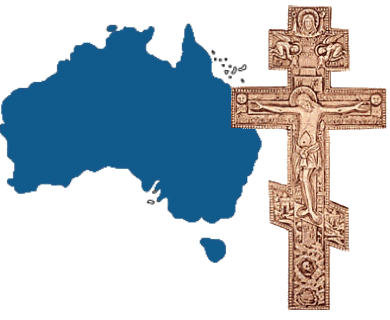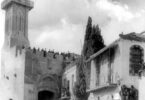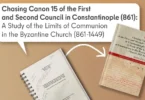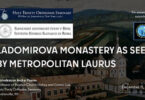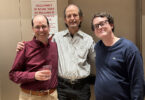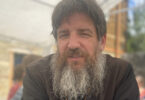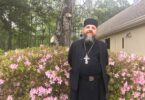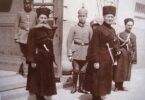A</spanpart from the occasional Liturgy celebrated in Australian ports by Russian Navy chaplains, [1] Cf. my earlier article, “Eastern Orthodoxy in Australasia: a forgotten chapter?” St. Vladimir’s Theological Quarterly 23 (1979), 181-185. there had been another little-known interlude before the establishment of regular Russian Orthodox parish life in the 1920’s. This was the ministry of the missioner Fr Jacob Korchinsky — not quite as transient as his predecessors, but due to adverse circumstances destined to spend only five months in Australia. [2] For much of the information on Fr Korchinsky I am indebted to Fr D. R. Rhodes and the OCA Archives. This episode seems to have escaped the notice of earlier writers in Australia entirely.
Largely as the result of the Russo-Japanese War, some thousands of Russians fled south from Siberia and Manchuria and found temporary refuge in Australia during the first two decades of this century. Although many of them had long been out of touch with church life before their arrival, some were very concerned to obtain regular Orthodox services and petitioned Archbishop Evdokim in the U.S.A, to provide them with a priest. [3] Amerikanskii Pravoslavnyi Vestnik XIX (1915), 427-428. On 30 September 1915, Evdokim gave permission for Fr Jacob Korchinsky to apply himself to this task, and for the issuing of an antimension, Holy Myron, etc. to him for use in his ministrations.
Born near Kiev in 1861, Jacob Korchinsky had been a teacher before ordination. He served as a mission-priest in Alaska between 1896 and 1900, then in Canada till 1902, when he returned to Russia because of his wife’s health. However, we find him in the U.S.A, again in 1908, serving parishes in Ohio and Pennsylvania, where he eventually rose to the position of Dean of the Second District. Fr Korchinsky spent nearly three months in Hawaii on the way to Australia, ministering to the spiritual needs of the Russian refugees there before proceeding to the fifth continent. Arriving in February 1916, he visited the main centres of Russian settlement — Sydney, Melbourne, Brisbane, Ipswich and Townsville — and met Fr A. Kantopoulos, who provided occasional services to some Russians in Victoria. A base was established in Brisbane with the assistance of the Anglican Church, which allowed him the use of St Andrew’s Mission Hall, South Brisbane, for his services. [4] The Anglican Church in Australia deserves praise for its long and generous provision of premises for Orthodox worship — still continuing in some places.
According to the report which Fr Korchinsky subsequently presented to Abp. Evdokim, [5] APV XX (1916), 696-697. there were some 5,000 Russians then living in scattered groups throughout the eastern states of Australia, of whom only one-third maintained any contact with the Church. If one looks to official documents of the period [6] E.g. the Report of the Commonwealth Census 1911 — the most detailed ever issued in Australia. for corroboration of these estimates, one is sadly disappointed. Leaving aside bureaucratic idiocy (which insisted on subsuming the Orthodox under the classification “Greek Catholic” until 1954, although even in 1911 only 415 of 2,646 so listed were actually this) and the confusion of many migrants (which resulted in their listing the name of the actual church they attended, rather than their denomination), one can calculate from a comparison of the various cross-classifications that there were probably only some 1,450 persons who were Russian Orthodox in name at least. The church collections would seem to support this lower number — a grand total of £11.3.4, i.e. roughly $56, for the whole five months!
This lack of financial support seems to have been the primary factor in the abandonment of the Australian Mission. As Fr Korchinsky pointed out rather plaintively in his Report, he had a family to support, and in fact had to apply to the Russian Consul in Melbourne for relief. Another factor was the religious indifference of the majority of the Orthodox Russians in Australia. Even though a priest was now available, many continued to live in unblessed unions and left their children unbaptized. According to Fr Korchinsky, this represented a continuation of the bad habits acquired during their sojourn in the Far East, where priests were few and far between. A third factor was the open hostility of a certain group led by the atheist Manovich-Zaytsev, whose attacks prevented Fr Korchinsky from pressing more vigorously for financial support from the people whom he was serving. [7] APV XX, 697. He left Australia after only five months, on the grounds of health problems, travelling via the Philippines and Japan to Russia, where the Revolution probably overtook him. In any event he did not return to the U.S.A. He noted in his final report to this Archbishop that jurisdiction over the Russian Orthodox in Australia had in fact been assigned by the Holy Synod to the Bishop of Japan in 1913. It appears, however, that the latter took no action then or subsequently. At that stage there were in fact more Russian than Greek Orthodox in Australia, and the history of Orthodoxy there might well have ended up similar to that in the U.S.A, had regular ecclesiastical structures been developed by the Mother Church. Instead, failure to provide proper support for the enthusiastic Fr Korchinsky and the consequent premature abandonment of the Australian Mission opened the way for the Russian Church Abroad to establish itself as virtually the sole Russian Orthodox jurisdiction there for the next half century.
While this must remain in the realm of speculation, it is interesting to consider what might have happened if the Australian Mission had flourished and retained its links with the American Archdiocese. After the Russian Revolution there would have been a group of parishes forming part of the “Mitropolia.” The latter would then not have appeared as an isolated and specifically American phenomenon, and perhaps would not have finally chosen the name “Orthodox Church in America” which caused so much misunderstanding and resentment. Certainly the Russian Orthodox in Australia would have profited enormously from the connection, being thus ensured of a supply of educated, English-speaking priests together with religious and educational material in English, and their whole outlook would probably have been more open and outward-looking. This would surely have facilitated the spread of positive knowledge about Orthodoxy in Australia, and would have promoted conversions as well, which because of the language-barrier have been pitifully few so far. However, none of this happened, as events moved in a different and less auspicious direction.
In the 1920’s, groups of Russian refugees who had escaped from or via the Far East began to settle in Australia, to be fol¬lowed by several later waves, almost all of whom submitted to the de facto hegemony of the Russian Church Abroad. [8]In view of the strongly anti-Soviet attitude of most churchgoing Russians in Australia, it is not surprising that the Moscow Patriarchate has never succeeded in establishing parishes there as it did … Continue reading
The first Russian Orthodox priest known to have settled in Australia permanently, as distinct from the various transient priests mentioned above, was Fr Aleksandr Shabashev, who arrived in Brisbane with other refugees from China and Manchuria c. 1922. In the following year he was joined by another priest, Fr Valentin Antonieff, [9]A detailed history of this period is being prepared by Dr M. Kravchenko, grand-daughter of Fr Antonieff. Some information can be found in С. M. Hotimsky: Russkie v Avstralii, Melbourne [19571- An … Continue reading who arrived via the same route and served in Brisbane until his death in 1962. Like most of the non-Greek priests of Orthodox jurisdictions in Australia, these pioneers had to support themselves and their families by dint of manual labour — often under very difficult conditions—and served their church and parishioners in their free time. Progressing from the original temporary house-chapel, the first proper Russian Orthodox church (dedicated to St Nicholas) was erected in Brisbane in 1926, and was rebuilt in 1933. Brisbane remained the centre for some years, and here the first journals were issued — Chuzbina in 1930 and Cerkovnyi Kolokol in 1932.
Services were held periodically in Sydney and other centres by clergy from Brisbane until 1933, when Archim, Mefodii (Slemin) [10] Russkaia Pravoslavnaia Cerkov Zagranicei 1918-1968, Jerusalem 1968 vol. II, 1318 ft. was appointed to head the Sydney community. In November 1935, Archim. Fyodor [11] Pravoslavnaia Rus’ (1937) 7, p. 6. arrived, sent by the Peking Mission — at that time responsible for Australia — to plan a missionary monastery to act as a centre for the scattered Russian Orthodox. It was resolved to establish a see there, [12] RPCZ, loc. cit. but World War II put an end to further developments, and even communications. In Sydney services were perforce held in borrowed premises until a house was bought near Centennial Park in 1938. Plans had originally been drawn up for a splendid traditional-style church to be built on Oxford St., the main arterial road from the city to the coast. However, war-time and post-war building restrictions prevented the realizaton of this plan, and as a compromise the house at Centennial Park was remodelled internally into a church, dedicated to St Vladimir, which is still in use.
As already mentioned, all these groups were under the jurisdiction of the Far East Province of the Russian Church Abroad initially, but with the difficulties caused by the outbreak of the War, they placed themselves under the spiritual protection of the Greek Orthodox Metropolitan in Sydney, since he was the only Orthodox hierarch in the country at that time. However, with the changed circumstances after the War and the huge influx of new Russian refugees and displaced persons, in 1946 the Synod Abroad (by that time in Munich) decided to establish a see for Australia and New Zealand, and sent Bp Feodor (Rafal’skii), [13]Feodor (Aleksandr Rafal’skii — not Rafailsky as in Seide, op. cit.) b. SW Ukraine?; 1918 Poland, 1920 priest, 1942 monk and Bp of Taganrog (Ukr. Auton. Ch.), 1943 of Rovno; 1943 Germany, joins … Continue reading although visa problems prevented him from taking possession of his new see until November 1948. It was estimated that at this juncture there were probably about 5,000 Russian Orthodox there in 11 parishes, with 16 priests and 3 deacons. [14] PR (1950) 2, p. 15. In 1949 Bp Feodor was raised to the rank of Archbishop, and in the following year he transferred his episcopal seat from Brisbane to Sydney, since this was now the focus of Russian settlement. His vicar-bishop Afanasii (Martos) [15]Afanasii (Antonii Martos): b. Zavita 1904; hieromonk 1933, 1942 Bp of Vitebsk (Byelorussian Autoc. Ch.); 1944 Germany, 1945 joins ROCA; 1950 Bp of Melbourne; 1955 Abp of Buenos Aires; d. 11.3.1983. … Continue reading was then moved from Melbourne to Brisbane to replace him.
Organization of the church proceeded apace, and in 1953 the imposing Cathedral of SS Peter and Paul was dedicated in the outer suburb of Strathfield, although the iconostas and other details took more time to finish. The Archbishop’s residence and chancery were located in outbuildings on the Cathedral site until 1960, when they were transferred to the neighboring suburb of Croydon.
However, the seeds of discord were already present, and after a disagreement with the Archbishop, Fr Igor Susemihl [16] Fr Susemihl later returned to Europe and became a bishop of the Moscow Patriarchate under the name of Iriney. Since 1975 Abp of Vienna. and his parish of St Mary’s Fitzroy (Melbourne) were received definitively into the jurisdiction of the Greek metropolitan. [17] None of these less pleasant facts are mentioned by Seide, op. cit., in his informative but rather biased book. Again one could speculate on what might have happened if the latter and the Phanar had been more mindful of the terms of the Tomos establishing the see for all Orthodox Christians in the area regardless of race and language, and had worked to retain the Russians after their voluntary affiliation during the War. Presumably it would have yielded a situation like that in America, with a family of different ethnic groups in one jurisdiction. One other parish consisting of Russians (plus some Greeks) was for some years associated with the Greek see, and there was a Polish Orthodox priest, Fr Boris Kamensky, in Queensland in the mid 50’s — but nothing significant developed.
Since 1949 a Russian diocesan journal has been issued, called Pravoslavnyi Khristianin till 1954, and subsequently Cerkovnoe Slovo. Another periodical under the name of Prisyv was also produced at irregular intervals for some time around 1967. Of particular interest is the journal of the Orthodox Laymen’s Association, Pravoslavnyi Vestnik, which only closed down in 1983, after being for some years a focus of discontent with the policies of the Synod hierarchy.
The first Diocesan Assembly was convoked in December 1950. Bp Afanasii proposed to establish a pastoral school in view of the age of most of the local clergy, but this did not happen, and clerical candidates continue to be sent from Australia to Jordanville for training. Other suggestions regarding the foundation of schools and kindergartens in the larger centres were eventually realized, however. [18] PR (1952) 2, 14-15.
The suggestion was again discussed to establish a monastery as a kind of spiritual centre, and this deserves special attention. It is curious that in Australia as in America the Russians, despite their smaller numbers, have been the chief proponents of Orthodox monasticism. (No fewer than six properties have been gifted to the Greek Archdiocese of Australia for monasteries, yet there is not one functioning, and in America the only flourishing Greek monasteries are under the Russian Synod!) As mentioned above, a proposal had already been made in the 30’s to establish a Russian monastic centre in Australia, but World War II intervened. In 1955 a start was made by the priest-monk Dmitrii (Obukhov) and his deacon brother Petr at Kentlyn, some 30 miles west of Sydney. After an enthusiastic beginning things stagnated, and the monastic complex and chapel were given over to some nuns — from Harbin originally, like the two monk brothers — under Mother Elena (Ustinova) [19] Originally the nuns ran the St Sergius Home for the Aged in nearby Cabramatta. Since the death of the aged Mother Elena on 4.18.1984, the small community has been headed by Mother Evpraksia. and renamed Novoe Samordino. Huts built on the extensive grounds were used for housing newly-arrived refugees from the Far East in the 50’s and 60’s, and since this tide of immigrants has dried up, they have been used for housing the aged, pilgrims and retreatants. In 1965 another attempt was made to found a viable men’s community by Schimonk Gurii (Demidov). [20] RPC Z II, 1240 ff. A hermitage dedicated to St John the Baptist was built not far from the nunnery, but the hoped-for novices did not materialize, and since the mid-70’s this monastic house has been deserted. However, yet another attempt is currently under way. A property has been bought in the Snowy Mountains, and a small wooden chapel has been built there. So far it has been used only for retreats and work-camps, but it is hoped that this will develop into a regular monastic community, under the guidance of the talented icon-painter Fr Alexis (Rouzentool). [21] Fr Alexis, trained at Jordanville, is assistant priest at the Church of the Intercession (Cabramatta), which he is painting. One of the main factors militating against the establishment of a community of monks is — as in previous periods — the dire shortage of priests. This means that priest-monks are assigned to serve in parishes, rather than allowed to follow their natural vocation, and this pattern seems likely to continue.
However, we must return to our main theme. On the transfer of Bp Afanasii to Buenos Aires in 1955, his place in Brisbane was taken by Bp Savva (Rayevskii), [22] Sawa (Feodor Raevskii): b.? 1892; —Yugoslavia, married priest; 1944 — Austria — USA; 1954 monk and Bp of Melbourne, 1955 Abp of Australia and N.Z., retired 1970; d. 4.17.1976. who had been vicar-bishop in Melbourne since the previous year. He in turn was succeeded there by Bp Antonii (Medvedev), [23] Antonii (Artemii Medvedev); b. Vilna 1908; hieromonk 1938; Bp of Melbourne 1956; Abp of San Francisco 1968. who retained this post until his appointment to the see of San Francisco in 1967. With the death of Abp Fyodor in May 1955, Bp Savva was given charge of the archdiocese, and in 1957 he was raised to the rank of Archbishop.
The 60’s saw further expansion, and in 1963 another vicar-bishop was consecrated for Brisbane: none other than Filaret (Voznesenskii), [24]Filaret (Georgii Voznesenskii); b. Kursk 1903; — China, hieromonk Harbin 1931, 1953—Hong Kong; Bp of Brisbane 1963; Metr of ROCA 1964. It is noteworthy that Filaret’s father, who became Bp … Continue reading who became the first Orthodox hierarch to be consecrated in Australia. However, his rapid promotion to the leadership of the Russian Church Abroad meant that he departed for New York the following year. Only in 1967 was the position refilled, with the appointment of Archim. Konstantin (Esenskii), [25] Konstantin (Manuil Esenskii); b. Petersburg 1907; celibate priest Paris 1932; — Germany — USA 1949; 1967 monk and Bp of Brisbane; Boston 1979; Richmond, U.K., 1981. who retained this post until 1976, since when it has again been vacant.
The year 1968 saw another split in the ranks of the Russian Church, this time a much more extensive one. Ostensibly caused by the decision of the Synod to change the registration of the church properties in Australia, it acted as a focus for the dis-satisfaction of many with the policies of the Synodal hierarchy. After endless alarums and excursions and the expenditure of considerable sums of money on court cases, the Synod won the Cathedral in Strathfield, which had been the centre of a long and bitter dispute. While some of the dissidents later returned to the jurisdiction of the ROCA, three separated parishes were eventually organised under the spiritual oversight of the OCA. Again, one might have thought it logical for these groups to follow the path of Susemihl and join with the Greek metropolitan. Nevertheless, probably because of the good relations between the hierarchs of the two local sees, it appears that they were rebuffed, and have since been ignored. [26] The Greek Archdiocese has pointedly ignored the OCA parishes and omitted them from SCCOCA and inter-Orthodox functions, despite the protests of the present writer. Many unedifying events took place during these troubled years, but they are best left unmentioned.
Abp Savva retired on grounds of health in 1970, and a new era dawned with the appointment of his successor, Bp Feodosii (Putilin), [27] Feodosii (Sergii Putilin); b. Voronez 1897; married priest in Germany 1948; 1950 Australia; 1964 monk and Bp of Melbourne, 1971 Abp of Australia and N.Z.; d. 8.25.1980. also a former married priest, who since 1969 had been vicar bishop in Melbourne. Raised to the rank of archbishop in 1971, he ruled the see till his death in 1980. With his long pastoral experience and gentle nature, Abp Feodosii managed to heal the wounds in his community and reconcile many of the faithful estranged by the litigation of the previous era. It was typical of the man that he chose to be buried in Perth beside his predeceased matushka rather than in solitary state in Sydney. Typical also that when on the initiative of the Greek Archbishop Stylianos an organization parallel to SCOBA, the Standing Conference of Canonical Orthodox Churches in Australia (SCCOCA), was formed in 1979, the Russian Orthodox Archdiocese was one of the founding members — although the Synod in America has never had links with SCOBA.
However, this happy state of unity and co-operation was not destined to endure, and under his successor Bp Pavel (Pavlov), [28] Pavel (Mikhail Pavlov): b. Warsaw 1927; hieromonk 1952 Brasil; Bp of Stuttgart 1967; 1980 of Australia and N.Z.; 1981 Abp. bishop there since 1980 and archbishop since 1981, the isolationist line of the parent body has gradually been implemented. At first priests of the Russian see still attended the annual SCCOCA Panorthodox Liturgy on Thomas Saturday, even though their hierarch was conspicuous by his absence; but this too has been stopped. It is no secret that the attitude of the Synod has been conditioned to some extent by changes in the approach of other jurisdictions under pressure from Moscow, but in Australia, where the configuration of Orthodoxy is different and de facto recognition of the ROCA was always given and co-operation encouraged, this seems particularly regrettable.
One must give credit to the ROCA and its devoted clergy for their enormous contribution — often made at considerable personal cost — to the welfare of their scattered flock in Australia. Like most immigrant churches it has played a significant role as a focus for community life, preserving traditional religion, culture and language, and easing the adjustment to the new homeland. Since most of the Russians came as refugees, they had no prospect of returning to their original homes, so permanent settlement was imperative. However, the present trend towards an unjustifiable isolation, even from their fellow Orthodox, means that this group’s contribution to the development of Australian Orthodoxy and Australian life in general is effectively curtailed. Also, the danger of Orthodoxy being narrowly identified with Hellenism — although the Hellenic component has been a small minority in world Orthodoxy for a thousand years — is thereby increased, and its character as an international, universal Church obscured.
Time alone will tell, but in the opinion of the present writer, disunity and separatism seem more likely to undermine the progress of Orthodoxy in Australia than any threats from communism and ecumenism. It is no wonder that he thinks nostalgically of what might have eventuated, if earlier opportunities had been followed up…
References
| ↵1 | Cf. my earlier article, “Eastern Orthodoxy in Australasia: a forgotten chapter?” St. Vladimir’s Theological Quarterly 23 (1979), 181-185. |
|---|---|
| ↵2 | For much of the information on Fr Korchinsky I am indebted to Fr D. R. Rhodes and the OCA Archives. This episode seems to have escaped the notice of earlier writers in Australia entirely. |
| ↵3 | Amerikanskii Pravoslavnyi Vestnik XIX (1915), 427-428. |
| ↵4 | The Anglican Church in Australia deserves praise for its long and generous provision of premises for Orthodox worship — still continuing in some places. |
| ↵5 | APV XX (1916), 696-697. |
| ↵6 | E.g. the Report of the Commonwealth Census 1911 — the most detailed ever issued in Australia. |
| ↵7 | APV XX, 697. |
| ↵8 | In view of the strongly anti-Soviet attitude of most churchgoing Russians in Australia, it is not surprising that the Moscow Patriarchate has never succeeded in establishing parishes there as it did in America and Europe. There are also several groups of Old Believers in Australia, but they require separate treatment. |
| ↵9 | A detailed history of this period is being prepared by Dr M. Kravchenko, grand-daughter of Fr Antonieff. Some information can be found in С. M. Hotimsky: Russkie v Avstralii, Melbourne [19571- An excellent historical over-view was given in C. Patock, “Die Ostkirchen in Australien,” Ostkirchliche Studien 27 (1978), 183-187, and more recently by G. Seide, Geschichte der Russischen Orthodoxen Kirche im Ausland von der Grilndung bis in die Gegenwart, Wiesbaden 1983. |
| ↵10 | Russkaia Pravoslavnaia Cerkov Zagranicei 1918-1968, Jerusalem 1968 vol. II, 1318 ft. |
| ↵11 | Pravoslavnaia Rus’ (1937) 7, p. 6. |
| ↵12 | RPCZ, loc. cit. |
| ↵13 | Feodor (Aleksandr Rafal’skii — not Rafailsky as in Seide, op. cit.) b. SW Ukraine?; 1918 Poland, 1920 priest, 1942 monk and Bp of Taganrog (Ukr. Auton. Ch.), 1943 of Rovno; 1943 Germany, joins ROCA; 1946 Bp of Australia and N.Z., 1950 Abp; d. 5.6.1955. |
| ↵14 | PR (1950) 2, p. 15. |
| ↵15 | Afanasii (Antonii Martos): b. Zavita 1904; hieromonk 1933, 1942 Bp of Vitebsk (Byelorussian Autoc. Ch.); 1944 Germany, 1945 joins ROCA; 1950 Bp of Melbourne; 1955 Abp of Buenos Aires; d. 11.3.1983. His writings on the Byelorussian Church were banned by the Synod of the ROCA, which prompted some controversy. |
| ↵16 | Fr Susemihl later returned to Europe and became a bishop of the Moscow Patriarchate under the name of Iriney. Since 1975 Abp of Vienna. |
| ↵17 | None of these less pleasant facts are mentioned by Seide, op. cit., in his informative but rather biased book. |
| ↵18 | PR (1952) 2, 14-15. |
| ↵19 | Originally the nuns ran the St Sergius Home for the Aged in nearby Cabramatta. Since the death of the aged Mother Elena on 4.18.1984, the small community has been headed by Mother Evpraksia. |
| ↵20 | RPC Z II, 1240 ff. |
| ↵21 | Fr Alexis, trained at Jordanville, is assistant priest at the Church of the Intercession (Cabramatta), which he is painting. |
| ↵22 | Sawa (Feodor Raevskii): b.? 1892; —Yugoslavia, married priest; 1944 — Austria — USA; 1954 monk and Bp of Melbourne, 1955 Abp of Australia and N.Z., retired 1970; d. 4.17.1976. |
| ↵23 | Antonii (Artemii Medvedev); b. Vilna 1908; hieromonk 1938; Bp of Melbourne 1956; Abp of San Francisco 1968. |
| ↵24 | Filaret (Georgii Voznesenskii); b. Kursk 1903; — China, hieromonk Harbin 1931, 1953—Hong Kong; Bp of Brisbane 1963; Metr of ROCA 1964. It is noteworthy that Filaret’s father, who became Bp Dmitrii of Hailar after his wife’s death, chose to return to USSR in 1946. |
| ↵25 | Konstantin (Manuil Esenskii); b. Petersburg 1907; celibate priest Paris 1932; — Germany — USA 1949; 1967 monk and Bp of Brisbane; Boston 1979; Richmond, U.K., 1981. |
| ↵26 | The Greek Archdiocese has pointedly ignored the OCA parishes and omitted them from SCCOCA and inter-Orthodox functions, despite the protests of the present writer. |
| ↵27 | Feodosii (Sergii Putilin); b. Voronez 1897; married priest in Germany 1948; 1950 Australia; 1964 monk and Bp of Melbourne, 1971 Abp of Australia and N.Z.; d. 8.25.1980. |
| ↵28 | Pavel (Mikhail Pavlov): b. Warsaw 1927; hieromonk 1952 Brasil; Bp of Stuttgart 1967; 1980 of Australia and N.Z.; 1981 Abp. |

